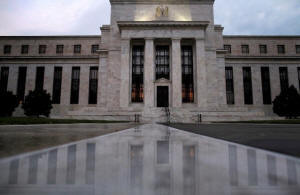|
Brexit a knockout punch
to Fed's interest rate divergence mantra
 Send a link to a friend
Send a link to a friend
 [June 25, 2016]
By Howard Schneider [June 25, 2016]
By Howard Schneider
WASHINGTON (Reuters) - Britain's shock
vote to leave the European Union may tie the U.S. Federal Reserve to
near zero interest rates for far longer than expected, according to new
research indicating the U.S. central bank is now tightly bound to
international economic conditions.
Over the past 18 months the Fed has blinked more than once, and
refrained from raising interest rates when global market volatility
has darkened the economic outlook, but the Fed has still maintained
that U.S. monetary policy could ultimately "diverge" toward higher
rates even in a weakened world economy.
That idea may now have suffered its final blow.
Fed research published this week found a strong link between the
movement of the long-run "natural" rate of interest in the U.S. and
other developed countries, meaning the Fed may be forced to keep
short term interest rates near zero until economic growth in other
developed economies accelerates and the uncertainty around "Brexit"
passes.
Other research has been begun documenting abnormally sharp moves in
the U.S. dollar in response to monetary conditions around the world
also.
With the U.S. dollar rising sharply on Friday after the Brexit vote
as investors poured money into safe-haven assets, the Fed may be
faced with a fresh drag on U.S. exports and job growth and another
hurdle to reaching its inflation target. The dollar rose more than
2.0 percent on Friday against a basket of major currencies.

Taken together, the conclusions are bad news for a central bank that
has staked its credibility on the need to nudge U.S. borrowing costs
higher. The research is especially bad news for the Fed's ability to
raise rates if the rest of the world remains a depressed amalgam of
negative interest rates and slow economic growth.
The Fed's position is "extremely challenging..In the current global
setting it will be extremely hard for the Fed to move long rates,"
said Massachusetts Institute of Technology economics professor
Ricardo Caballero.
Research by Caballero and colleagues at MIT and Harvard is among a
number studies indicating that monetary policy, instead of acting
through its influence on short and long-run borrowing costs, is
being felt more acutely on currency markets. In the case of the U.S.
that has meant a strong dollar, resulting in a drag on exports,
manufacturing activity and job growth.
"I think the Fed is going to be worried about the second round
consequences for the European Union," said Thomas Costerg, a New
York-based economist with Standard Chartered Bank.
"Even with stronger U.S. data, I don't think the Fed will tighten
policy. It has already been anxious about the global picture, it is
increasingly behaving like the central bank of the world, and it
will likely remain really worried about what it means for the EU,"
he said.
It remains an article of faith at the Fed that U.S. monetary policy
can follow its own course. On Wednesday of last week Fed Chair Janet
Yellen told a Congressional committee that while conditions in the
rest of the world matter to the Fed, "it doesn't mean we can never
escape zero interest rates."
[to top of second column] |

The facade of the U.S. Federal Reserve building is reflected on wet
marble during the early morning hours in Washington, July 31, 2013.
REUTERS/Jonathan Ernst

However the difficulties of divergence have increasingly worked their way into
Fed research, internal debate, and public pronouncements.
A day after Yellen spoke, the Fed released a new paper co-authored by Fed board
economist Kathryn Holston, Monetary Affairs director Thomas Laubach, and San
Francisco Fed President John Williams suggesting that while the Fed might escape
zero interest rates, its pace of monetary tightening and the long-run
destination of the target overnight rate was to some degree anchored by what
happens in Europe, the United Kingdom and elsewhere.
Estimates of the long-run natural rate of interest are imprecise, but form an
important guide for policymakers as the point at which the economy grows at
potential without accelerating inflation.
Using methods often cited in Fed debate, they found that natural rates in the
euro region, the United Kingdom and Canada had all fallen alongside the U.S.
rate over the last quarter century, and that interest rates in all four were
likely to rise and fall together in the future.
Though noting the difficulties of estimating an economic variable that cannot be
observed, the paper concluded that as much as a third of the variation in the
U.S. natural rate of interest came from abroad.
One implication: as long as Europe remains stuck with slow economic growth and
negative rates, the tougher it will be for the U.S. interest rates to move
higher and allow Fed tightening to proceed. Economists say the European Central
Bank may have to further loosen policy in response to Britain's leave vote.
There were similar implications in recent studies of how the U.S. dollar is
reacting to international events, including yet-to-be published Fed research
cited by Fed Governor Lael Brainard recently, along with Caballero's findings,
urging the Fed to be cautious in any rate hike.

"The feedback loop through exchange rate and financial market channels appears
to be elevated," Brainard said. "Several factors suggest that the appropriate
path to return monetary policy to a neutral stance could turn out to be quite
shallow."
(Reporting by Howard Schneider; Editing by David Chance)
[© 2016 Thomson Reuters. All rights
reserved.] Copyright 2016 Reuters. All rights reserved. This material may not be published,
broadcast, rewritten or redistributed. |